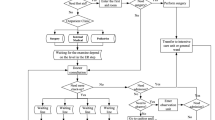Abstract
This study aims to investigate medical resource allocation problems by multi-objective simulation optimization to address the long-term overcrowding situations experienced in hospital emergency departments (EDs). With resource constraints considered, decision makers at EDs must determine the number of doctors, nurses, lab technicians, and other medical equipment to allocate efficiently these medical resources and simultaneously minimize the average patient length of stay in the system and the medical resource wasted cost. Therefore, this study first proposes a multi-objective stochastic optimization model to identify the optimal number of all medical resources at the EDs. In addition, a multi-objective simulation optimization algorithm by integrating non-dominated sorting particle swarm optimization (NSPSO) with multi-objective computing budget allocation (MOCBA) and an ED simulation model is developed and constructed to address this problem, respectively. Specifically, NSPSO searches for potential solutions to medical resource allocation problems. MOCBA identifies effective sets of feasible Pareto medical resource allocation solutions and effective allocation of simulation replications. An ED simulation model based on the operation flows of EDs in Taiwan was constructed to estimate the expected performance value of each resource allocation solution generated by NSPSO. The effectiveness and performance of integrated NSPSO and MOCBA was verified by computational experiments.










Similar content being viewed by others
References
Ahmed MA and Alkhamis TM (2009). Simulation optimization for an emergency department healthcare unit in Kuwait. European Journal of Operational Research 198 (3): 936–942.
Altinel IK and Ulas E (1996). Simulation modeling for emergency bed requirement planning. Annals of Operations Research 67 (1): 183–210.
Benabid R, Boudour M and Abido MA (2009). Optimal location and setting of SVC and TCSC devices using non-dominated sorting particle swarm optimization. Electric Power Systems Research 79 (12): 1668–1677.
Cabrera E, Taboada M, Iglesias ML, Epelde F and Luque E (2012). Simulation optimization for healthcare emergency departments. Procedia Computer Science 9: 1464–1473.
Chan CL, Huang HT and You HJ (2012). Intelligence modeling for coping strategies to reduce emergency department overcrowding in hospitals. Journal of Intelligent Manufacturing 23 (6): 2307–2318.
Chen CH and Lee LH (2010). Stochastic Simulation Optimization: An Optimal Computing Budget Allocation. World Scientific Publishing Co.: Singapore.
Chew EP, Lee LH, Teng S and Koh CH (2009). Differentiated service inventory optimization using nested partitions and MOCBA. Computers & Operations Research 36 (5): 1703–1710.
Cochran JK and Roche KT (2009). A multi-class queuing network analysis methodology for improving hospital emergency department performance. Computers & Operations Research 36 (5): 1497–1512.
Deb K, Member A, Pratap A, Agarwal S and Meyarivan T (2002). A fast and elitist multiobjective genetic algorithm. IEEE Transaction on Evolutionary Computation 6 (2): 182–197.
Green LV, Soares J, Giglio JF and Green RA (2006). Using queueing theory to increase the effectiveness of emergency department provider staffing. Academic Emergency Medicine 13 (1): 61–68.
Hoot NR and Aronsky D (2008). Systematic review of emergency department crowding: Causes, effects, and solutions. Health Policy and Clinical Practice 52 (2): 126–136.
Hulshof PJH, Kortbeek N, Boucherie RJ, Hans EW and Bakker PJM (2012). Taxonomic classification of planning decisions in health care: A structured review of the state of the art in OR/MS. Health System 1 (2): 129–175.
Law AM (2007). Simulation Modeling and Analysis. McGraw-Hill: New York.
Lee LH, Chew EP, Teng S and Goldsman D (2010). Finding the non-dominated Pareto set for multi-objective simulation models. IIE Transactions 42 (9): 656–674.
Lee LH, Chew EP, Teng S and Yankai C (2008). Multi-objective simulation-based evolutionary algorithm for an aircraft spares parts allocation problem. European Journal of Operational Research 189 (2): 476–491.
Li BB, Wang L and Liu B (2008). An effective pso-based hybrid algorithm for multiobjective permutation flow shop scheduling. IEEE Transactions on Systems, Man, and Cybernetics—Part A: Systems and Humans 38 (4): 818–831.
Li X (2003). A non-dominated sorting particle swarm optimizer for multiobjective optimization. Lecture Notes in Computer Science, Vol. 2723, pp 37–48.
Vassilacopoulos G (1985). Allocating doctors to shifts in an accident and emergency department. The Journal of the Operational Research Society 36 (6): 517–523.
Wu JZ, Chien CF and Gen M (2012). Coordinating strategic outsourcing decisions for semiconductor assembly using a bi-objective genetic algorithm. International Journal of Production Research 50 (1): 235–260.
Xu M, Wong TC and Chin KS (2013). Modeling daily patient arrivals at emergency department and quantifying the relative importance of contributing variables using artificial neural network. Decision Support Systems 54 (3): 1488–1498.
Zeltyn S et al (2011). Simulation-based models of emergency departments: Operational, tactical and strategic staffing. ACM Transactions on Modeling and Computer Simulation 21 (4): 24.
Acknowledgements
The authors gratefully acknowledge the National Science Council, Taiwan, R.O.C., for support under contract NSC101-2221-E-030-014.
Author information
Authors and Affiliations
Corresponding author
Appendices
Appendix A
A.1. Simulation data
Tables A1, A2 and A3 list all input data and simulation parameters for the emergency department simulation model.
Appendix B
B.1. Evaluation performance metrics of Pareto-optimal front
-
Coverage metric: the coverage metric used to compare Pareto front E 1 and Pareto front E 2. When C(E 1, E 2)=1, E 1 dominates E 2. Conversely, if none of the solutions in E 2 can be dominated by any points in E 2, then C(E 1, E 2)=0. Notice that the C-metric is asymmetrical, that is, C(E 1, E 2)≠1−C(E 2, E 1). The definition of the coverage metric shows as follows.

-
Maximum spread metric: a maximum spread metric used to measure the percentage of range that the solution set covers the optimal Pareto front. Higher values are better. The definition of the maximum spread metric is shown as follows.

-
Tan’s spacing metric: a spacing metric used to measure how evenly the solutions are distributed. A small metric value means that the solutions are uniformly distributed and the Pareto front is better. The definition of the Tan’s spacing metric is shown as follows.


Rights and permissions
About this article
Cite this article
Chen, TL., Wang, CC. Multi-objective simulation optimization for medical capacity allocation in emergency department. J Simulation 10, 50–68 (2016). https://doi.org/10.1057/jos.2014.39
Received:
Accepted:
Published:
Issue Date:
DOI: https://doi.org/10.1057/jos.2014.39




